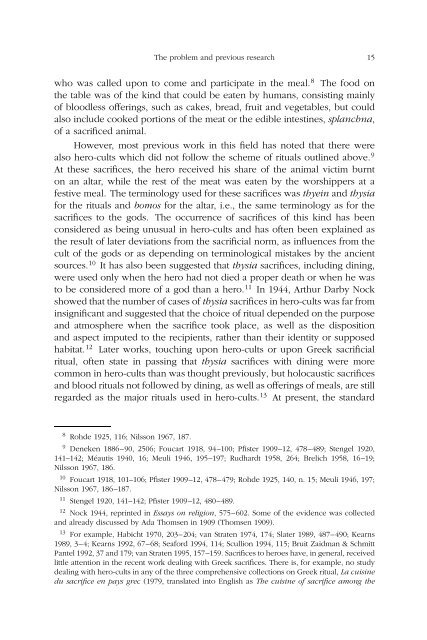The sacrificial rituals of Greek hero cults in the Archaic to the early ...
The sacrificial rituals of Greek hero cults in the Archaic to the early ...
The sacrificial rituals of Greek hero cults in the Archaic to the early ...
You also want an ePaper? Increase the reach of your titles
YUMPU automatically turns print PDFs into web optimized ePapers that Google loves.
<strong>The</strong> problem and previous research 15<br />
who was called upon <strong>to</strong> come and participate <strong>in</strong> <strong>the</strong> meal. 8 <strong>The</strong> food on<br />
<strong>the</strong> table was <strong>of</strong> <strong>the</strong> k<strong>in</strong>d that could be eaten by humans, consist<strong>in</strong>g ma<strong>in</strong>ly<br />
<strong>of</strong> bloodless o�fer<strong>in</strong>gs, such as cakes, bread, fruit and vegetables, but could<br />
also <strong>in</strong>clude cooked portions <strong>of</strong> <strong>the</strong> meat or <strong>the</strong> edible <strong>in</strong>test<strong>in</strong>es, splanchna,<br />
<strong>of</strong> a sacrificed animal.<br />
However, most previous work <strong>in</strong> this field has noted that <strong>the</strong>re were<br />
also <strong>hero</strong>-<strong>cults</strong> which did not follow <strong>the</strong> scheme <strong>of</strong> <strong>rituals</strong> outl<strong>in</strong>ed above. 9<br />
At <strong>the</strong>se sacrifices, <strong>the</strong> <strong>hero</strong> received his share <strong>of</strong> <strong>the</strong> animal victim burnt<br />
on an altar, while <strong>the</strong> rest <strong>of</strong> <strong>the</strong> meat was eaten by <strong>the</strong> worshippers at a<br />
festive meal. <strong>The</strong> term<strong>in</strong>ology used for <strong>the</strong>se sacrifices was thye<strong>in</strong> and thysia<br />
for <strong>the</strong> <strong>rituals</strong> and bomos for <strong>the</strong> altar, i.e., <strong>the</strong> same term<strong>in</strong>ology as for <strong>the</strong><br />
sacrifices <strong>to</strong> <strong>the</strong> gods. <strong>The</strong> occurrence <strong>of</strong> sacrifices <strong>of</strong> this k<strong>in</strong>d has been<br />
considered as be<strong>in</strong>g unusual <strong>in</strong> <strong>hero</strong>-<strong>cults</strong> and has <strong>of</strong>ten been expla<strong>in</strong>ed as<br />
<strong>the</strong> result <strong>of</strong> later deviations from <strong>the</strong> <strong>sacrificial</strong> norm, as <strong>in</strong>fluences from <strong>the</strong><br />
cult <strong>of</strong> <strong>the</strong> gods or as depend<strong>in</strong>g on term<strong>in</strong>ological mistakes by <strong>the</strong> ancient<br />
sources. 10 It has also been suggested that thysia sacrifices, <strong>in</strong>clud<strong>in</strong>g d<strong>in</strong><strong>in</strong>g,<br />
were used only when <strong>the</strong> <strong>hero</strong> had not died a proper death or when he was<br />
<strong>to</strong> be considered more <strong>of</strong> a god than a <strong>hero</strong>. 11 In 1944, Arthur Darby Nock<br />
showed that <strong>the</strong> number <strong>of</strong> cases <strong>of</strong> thysia sacrifices <strong>in</strong> <strong>hero</strong>-<strong>cults</strong> was far from<br />
<strong>in</strong>significant and suggested that <strong>the</strong> choice <strong>of</strong> ritual depended on <strong>the</strong> purpose<br />
and atmosphere when <strong>the</strong> sacrifice <strong>to</strong>ok place, as well as <strong>the</strong> disposition<br />
and aspect imputed <strong>to</strong> <strong>the</strong> recipients, ra<strong>the</strong>r than <strong>the</strong>ir identity or supposed<br />
habitat. 12 Later works, <strong>to</strong>uch<strong>in</strong>g upon <strong>hero</strong>-<strong>cults</strong> or upon <strong>Greek</strong> <strong>sacrificial</strong><br />
ritual, <strong>of</strong>ten state <strong>in</strong> pass<strong>in</strong>g that thysia sacrifices with d<strong>in</strong><strong>in</strong>g were more<br />
common <strong>in</strong> <strong>hero</strong>-<strong>cults</strong> than was thought previously, but holocaustic sacrifices<br />
and blood <strong>rituals</strong> not followed by d<strong>in</strong><strong>in</strong>g, as well as o�fer<strong>in</strong>gs <strong>of</strong> meals, are still<br />
regarded as <strong>the</strong> major <strong>rituals</strong> used <strong>in</strong> <strong>hero</strong>-<strong>cults</strong>. 13 At present, <strong>the</strong> standard<br />
8 Rohde 1925, 116; Nilsson 1967, 187.<br />
9 Deneken 1886–90, 2506; Foucart 1918, 94–100; Pfister 1909–12, 478–489; Stengel 1920,<br />
141–142; Méautis 1940, 16; Meuli 1946, 195–197; Rudhardt 1958, 264; Brelich 1958, 16–19;<br />
Nilsson 1967, 186.<br />
10 Foucart 1918, 101–106; Pfister 1909–12, 478–479; Rohde 1925, 140, n. 15; Meuli 1946, 197;<br />
Nilsson 1967, 186–187.<br />
11 Stengel 1920, 141–142; Pfister 1909–12, 480–489.<br />
12 Nock 1944, repr<strong>in</strong>ted <strong>in</strong> Essays on religion, 575–602. Some <strong>of</strong> <strong>the</strong> evidence was collected<br />
and already discussed by Ada Thomsen <strong>in</strong> 1909 (Thomsen 1909).<br />
13 For example, Habicht 1970, 203–204; van Straten 1974, 174; Slater 1989, 487–490; Kearns<br />
1989, 3–4; Kearns 1992, 67–68; Seaford 1994, 114; Scullion 1994, 115; Bruit Zaidman & Schmitt<br />
Pantel 1992, 37 and 179; van Straten 1995, 157–159. Sacrifices <strong>to</strong> <strong>hero</strong>es have, <strong>in</strong> general, received<br />
little attention <strong>in</strong> <strong>the</strong> recent work deal<strong>in</strong>g with <strong>Greek</strong> sacrifices. <strong>The</strong>re is, for example, no study<br />
deal<strong>in</strong>g with <strong>hero</strong>-<strong>cults</strong> <strong>in</strong> any <strong>of</strong> <strong>the</strong> three comprehensive collections on <strong>Greek</strong> ritual, La cuis<strong>in</strong>e<br />
du sacrifice en pays grec (1979, translated <strong>in</strong><strong>to</strong> English as <strong>The</strong> cuis<strong>in</strong>e <strong>of</strong> sacrifice among <strong>the</strong>



